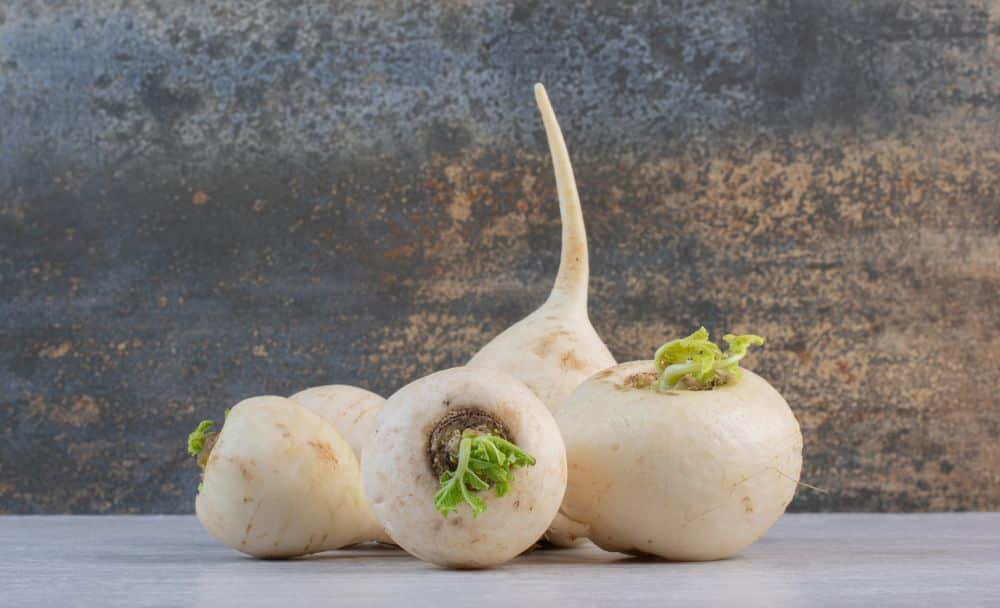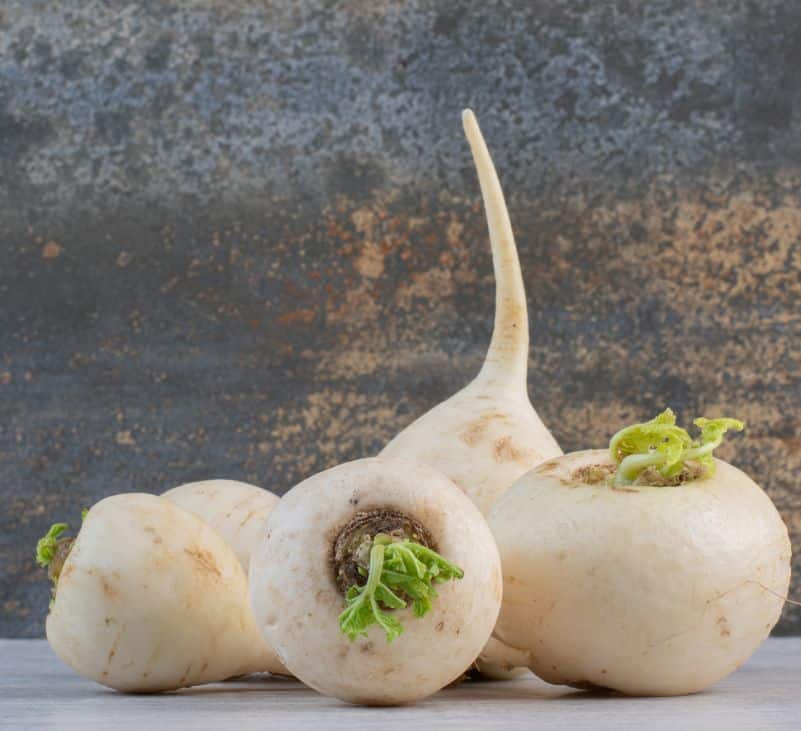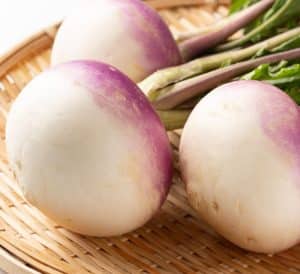
When it comes to versatile root vegetables, turnips, also known as shalgam in Hindi deserve a spot in the limelight. These humble veggies, known for their distinct flavor and vibrant appearance, pack a powerful nutritional punch. With several vitamins and minerals, shalgam offer several health benefits that make them a must-add to your diet.
This article explores the nutritional value of turnips and delves into the 15 turnip benefits for health. So, let’s discover why turnips should feature prominently in your culinary adventures and wellness journey.
What is the turnip?
Turnips, scientifically known as Brassica rapa, are root vegetables that belong to the cruciferous family. People have cultivated and enjoyed them for centuries due to their unique flavor and nutritional properties. These round or bulbous vegetables have white, purple, or yellowish skin, while the inner flesh is usually white or pale yellow.
Turnips or shalgam are known for their earthy and slightly peppery taste, which adds a delightful zest to various dishes. With a crunchy texture when raw and a soft, tender consistency when cooked, turnips offer a delicious addition to your meals. [1]
Nutritional Value Of Turnip [2]
| Constituents | Amount |
| Water | 91.9gm |
| Energy | 28kcal |
| Protein | 0.9g |
| Fat | 0.1g |
| Total Sugar | 3.8g |
| Calcium | 30mg |
| Iron | 0.3mg |
| Magnesium | 11mg |
15 health benefits of turnip
Here are 15 ways your health can benefit from consuming the turnip vegetable: [1]
- Relieves headaches and chest issues
Ayurveda mentions numerous benefits of shalgam. Turnip vegetable has a long history of traditional medicinal use, with applications in treating headaches and chest complaints.

- Potent remedy
Turnip benefits for health are immense. They effectively alleviate rheumatism, edemas, gonorrhea, syphilis, and even rabies.
- Anti-cancer
Shalgam, in English, known as Turnip contains glucosinolates and isothiocyanates, such as 2-phenylmethyl, 4-pentenyl, and 3-butenyl derivatives, contributing to their diverse bioactivities, particularly their protective effect against various cancers.
- Antitumor
The presence of these compounds gives turnip vegetables potential antitumor properties, making them valuable in cancer prevention and treatment.
- Antihypertensive
Ayurveda provides numerous uses of shalgam. Turnips possess antihypertensive properties, which can help regulate blood pressure levels.
- Antidiabetic
With their low glycemic index, turnips are beneficial for managing diabetes and maintaining stable blood sugar levels.
- Antioxidants
Ayurveda mentions numerous turnip benefits for health. Rich in antioxidants, turnips help combat oxidative stress and protect the body against cellular damage caused by free radicals.
- Anti-inflammatory
The anti-inflammatory properties of turnips contribute to reducing inflammation in the body and mitigating related health conditions.
- Hepatoprotective
Turnips exhibit hepatoprotective effects, supporting liver health and aiding in detoxification processes.
- Nephroprotective
Shalgam benefits are many. It has nephroprotective effects, promoting kidney health and preventing damage to renal tissues.
- Hypolipidemic
Turnips also demonstrate a hypolipidemic potency, helping to lower cholesterol levels and supporting cardiovascular health.
- Dietary fiber
The fiber content in turnips aids in digestion, promoting regular bowel movements and preventing constipation.
- Anti-obesity potency
Turnips are an excellent addition to a weight-loss or weight-management diet.
- Cardiovascular effects
Turnips have cardiovascular benefits due to their high content of heart-healthy nutrients.
- Flavonoids
Turnips are a good source of flavonoids, which are plant compounds with antioxidant properties. Flavonoids help protect the body’s cells from damage caused by free radicals.
How to consume turnip
Incorporating turnips or shalgam into your diet is a simple way to take advantage of their nutritional benefits. Here are some suggestions on how to consume turnips:
- Raw
Enjoy turnips in their raw form by adding thin slices or grated pieces to salads or slaws. Their crunchy texture and slightly peppery taste add a refreshing element to your dishes.
- Roasted
Roasting brings out the sweetness and creates a caramelized flavor. Toss peeled and cubed turnips with olive oil, salt, and pepper. Then, roast until tender and golden brown.
- Mashed
You can boil and mash turnips like potatoes to create a creamy and flavorful side dish. Add a touch of butter or cream, season with herbs and spices, and mash until smooth.
- Steamed
Steaming turnips is a quick and healthy cooking method that preserves nutrients. Slice or cube the turnips and steam until tender. Enjoy them as a side dish or incorporate them into stir-fries.
- Soups and stews
Turnips are excellent in soups and stews, adding a mild, earthy flavor and a hint of sweetness. Add diced turnips to your favorite recipes and let them simmer until they are soft and flavorful.
- Pickled
Pickling turnips is a popular method that adds tanginess and preserves them for a longer shelf life. Slice the turnips, then soak them in a mixture of vinegar, water, and spices for a few days before enjoying them as a condiment or snack.
- Grilled
For a unique twist, try grilling turnips. Slice them into thick rounds or wedges, brush with olive oil, and grill until tender with beautiful grill marks.

Turnip and Ayurveda
Turnips have long been valued in Ayurveda for their therapeutic properties and health benefits. According to Ayurvedic principles, turnip benefits include qualities that can influence our well-being based on taste (rasa), energy (virya), and a post-digestive effect (vipaka).
In Ayurveda, turnips have a cooling energy (virya) and a sweet taste (rasa). It makes them particularly beneficial for pacifying Pitta dosha, the dosha associated with heat and inflammation. Turnips can help balance excess heat in the body and support a calm and relaxed state.
Turnips or shalgam are also known for their digestive benefits, as they stimulate the digestive fire (agni) and promote healthy digestion. Including turnips in your diet can help promote stability and nourishment.
As with any dietary recommendations, consulting with a qualified Ayurvedic practitioner is essential to understand how to incorporate turnips into your individual constitution and health needs. They can provide personalized guidance on the appropriate quantity and preparation methods for optimal benefits.
FAQs
Disclaimer
This article is from a health and wellness perspective only and does not constitute medical advice. Kindly seek the help of a trained medical practitioner before initiating any treatment.
Conclusion
Turnips are an extraordinary root vegetable that adds flavor and vibrancy to your meals. They also offer impressive health benefits. Packed with essential nutrients, antioxidants, and fiber, turnips support digestion, cardiovascular health, and immune function. Whether you enjoy them raw in salads, roasted as a side dish, or incorporated into soups and stews, turnip vegetable provides a nutritious addition to your culinary experience. So why not embrace the goodness of turnips and savor their remarkable health benefits as you embark on your journey toward a healthier lifestyle?
What is the scientific name of turnip?
The scientific name of turnip is Brassica rapa. It belongs to the Brassicaceae family and is part of the same family as cabbage, broccoli, and kale.
What is turnip?
Turnip is a root vegetable that belongs to the cruciferous family. The term “turnip” describes both the vegetable itself and the plant it grows from.
What are turnip benefits?
Turnips are rich in vitamins, minerals, and antioxidants, which support immunity and digestion. They have potential anti-inflammatory, antitumor, antihypertensive, and antioxidant properties.
How to consume turnip vegetables?
You can eat raw turnips by slicing or grating them in salads or slaws. You can also roast, mash, steam, or grill turnips. Each method offers a unique flavor and texture.
How to grow a turnip plant?
Prepare well-drained soil with organic matter. Sow turnip seeds directly into the garden bed and space them accordingly. Ensure the ground remains consistently moist and has adequate sunlight. Thin the seedlings as they grow to allow space for proper development. Harvest turnips when they reach the desired size, typically around 6-8 weeks after sowing.
Conclusion
Turnips are an extraordinary root vegetable that adds flavor and vibrancy to your meals. They also offer impressive health benefits. Packed with essential nutrients, antioxidants, and fiber, turnips support digestion, cardiovascular health, and immune function.
Whether you enjoy them raw in salads, roasted as a side dish, or incorporated into soups and stews, turnip vegetable provides a nutritious addition to your culinary experience. So why not embrace the goodness of turnips and savor their remarkable health benefits as you embark on your journey toward a healthier lifestyle?
Disclaimer:This article is from a health and wellness perspective only and does not constitute medical advice. Kindly seek the help of a trained medical practitioner before initiating any treatment.




















